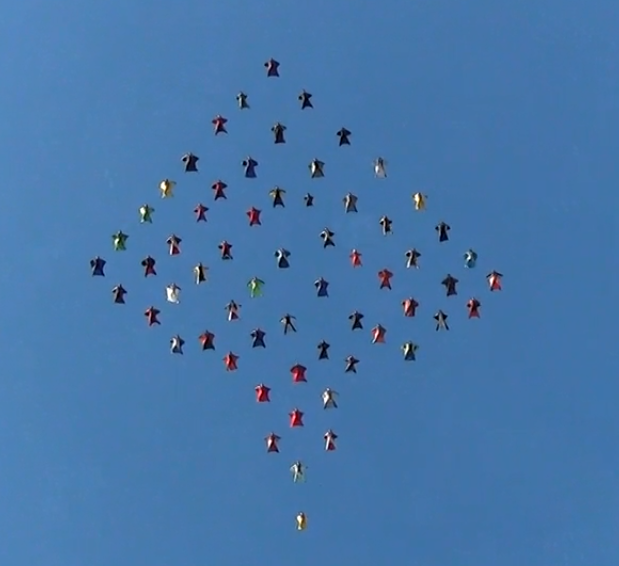QuoteInsect flight is very well understood by science at this time.
Irrespective of what science can or cannot prove, obviously anyone who asserts that bumblebees can't fly (1) has never seen one; (2) has seen one and didn't know what it was; (3) is schizophrenic; or (4) is intellectually challenged beyond belief.
Entomologists wouldn't quibble over rudimentary field observations that might peak the curiosity of a physicist.
D--
lug 4
Exit order first to last by group discipline
1) Belly flyers largest to smallest
2) Freeflyers largest to smallest
3) Coaching students
4) AFF
5) Tandems
6) Birdman
7) High pulls
Why?
Because of free fall drift caused by the winds aloft and the amount of free fall time a jumper is exposed to those winds. Check out the articles found under “Safety” on this web site then go to the subject “Exit” the articles explains the subject well. You will find Kallend’s and Tim Wagner’s simulator programs as will as articles written by Bryan Burke and Winsor Naugler. This is why my home DZ has the above exit order.
billvon 3,070
No one ever did. The report that people keep referring to was one that said that, if you designed a bumblebee like an airplane, it could not keep itself in the air. Science does this all the time. For example, people are currently noting that, if gravitation were the sole governing factor in the expansion and contraction of the universe, the universe would be behaving differently than it is. A skeptic might translate that as "scientists claim gravity doesn't exist!" What it means in reality is that there's more to the expansion of the universe than we currently understand.
MWGemini 0
Freeflyers (big groups first)
Belly Flyers/RW (big groups first)
Solos/mid range pulls (i.e.- pulls between 6k and 4k)
Tandems
Wingsuits/hop & pop from altitude
The reason I did not put CRW on there is because I've only seen it done on a few loads, and there are usually two runs, a CRW run, and then a run as described above. Also, the WS/H&P are on the same line because I've heard it done both ways, but the one time I've seen it done, I exited before the WS when I was planning on being last out and doing a H&P. That turned into a 5-10 second delay while I made sure the WS was nowhere near me, but that is another story.
Bottom line- my DZ puts FF out first, generally starts the run a little short of the DZ (I'm assuming to allow enough time for the tandems to get back, and they are last out due to higher opening altitudes), and has not had any collisions or close calls that I know of. While I have read Dr. Kallend's report (albeit while much newer to the sport and I did not fully understand it) and have used his freefall software and do understand what he is saying and do agree with him, my (very) limited experience shows that it is not gospel, and things CAN be done another way and still be done safely. Perhaps not as efficiently, or with a smaller margin of error, but that is beyond my experience level to comment on.
Mike
Edit: I have only jumped a Cessna once, so all these observations were done either in a Twin Otter or a CASA. I jump at Carolina Sky Sports in Louisburg, NC.
billvon 3,070
>CAN be done another way and still be done safely.
"Safely" is a matter of opinion. If you leave on the order of 30 seconds between the last freeflyer and first RW jumper in normal winds, then it can be done safely. If you don't, well - you're not going to get adequate separation. The big-sky theory means you will usually get away with it, but eventually the odds will catch up with you.
It's like anything else. You can jump a Nitro 108 loaded 2 to 1 at the 50 jump mark; you can probably land without serious injury 99 times out of 100 with some native skill, soft grass and a little luck. Does that mean that a Nitro 98 can be jumped safely by someone with 50 jumps?
One of the cool things about skydiving now is that we have a lot of experience to draw on about what works and what doesn't. That's why we got away from ROL pilot chutes, and Capewells, and blast handles, and that's why most people put RWers out first now. You can get away without doing it for quite a while, but experience has shown that it will eventually bite you. Hopefully it won't come to that.
MWGemini 0
Mike
speedy 0
CSS was using a crosswind jump run, which means you have less of a problem with freefall drift and can put free fliers out first.
Fallschirmsport Marl
Curious that CSS operates this way...
(69-way, 108-way and 138/142-way Freefly World Records)
billvon 3,070
A few DZ's do. Skydive Arizona has actually started experimenting with _curved_ jump runs; lets you get more groups out per pass.
kallend 2,106
Quote>Curious that CSS operates this way...
A few DZ's do. Skydive Arizona has actually started experimenting with _curved_ jump runs; lets you get more groups out per pass.
Ask Diverdriver about this. He (and others pilots at SDC) has flown curved jumpruns for some time now.
The only sure way to survive a canopy collision is not to have one.
Quote
Ask Diverdriver about this. He (and others pilots at SDC) has flown curved jumpruns for some time now.
What's a matter with them, can't they fly straight?
It's one soloution as is a crosswind run in. How about considering a diagonal (straight) run in. Will have to take various factor, such as wind direction & DZ size/shape, into account.
Again, no 'one size fits all' answer but with all this information each DZ suould be able to create a (or a number of) 'tailor made' solution(s) to suit their situations.
Stay Safe, have fun.
Get out, Land on a green bit. If you get the pull somewhere in between it would help.
Douva 0
Quote
..and obiously wingsuit an surfers last
If they do have a policy do you know why?
Actually, almost all drop zones put out skysurfers first. Generally, skysurfers fall slightly slower than belly flyers. Unlike wingsuit jumpers, skysurfers don't track for the duration of a jump. Their slow fall rate, combined with a vertical body orientation that catches even more of the upper winds, causes skysurfers to drift a great deal. You don't want to put skysurfers out last, without significant added separation, because they may drift over groups that exited before them.
billvon 3,070
>separation, because they may drift over groups that exited before them.
I think a more practical reason at many DZ's is that there's just no room to set up a board near the front of a packed Otter.
Douva 0
Quote>You don't want to put skysurfers out last, without significant added
>separation, because they may drift over groups that exited before them.
I think a more practical reason at many DZ's is that there's just no room to set up a board near the front of a packed Otter.
Sure, there are other reasons why it works best to put skysurfers out first (also reduces the chance of dropping a board on another jumper under canopy, not that this is a real danger), but the physics of wind drift do work in favor of skysurfers exiting first.
QuoteActually, almost all drop zones put out skysurfers first.
Hehe in theory maybe, but how many DZs have any skysurfers? I've jumped at about 9 DZs for 6 years and have never seen a single skysurfer. But I'm sure we'd stick ya by the door (if skysurfing is even allowed up here...).
Dave
Douva 0
QuoteQuoteActually, almost all drop zones that have skysurfers put out skysurfers first.
Hehe in theory maybe, but how many DZs have any skysurfers? I've jumped at about 9 DZs for 6 years and have never seen a single skysurfer. But I'm sure we'd stick ya by the door (if skysurfing is even allowed up here...).
Is that better?
Dave
bmcd308 0
So does Mullins, on occasion. And lots of time he will call a separate exit for each group, using his GPS to ensure that the jumpers don't give quick counts.
----------------------------------
www.jumpelvis.com
Scrumpot 1
Quotebut how many DZs have any skysurfers? I've jumped at about 9 DZs for 6 years and have never seen a single skysurfer.
That's your problem Dave... In 6 years time, you just ahve not either: Jumped enough, or have lasted at any one given dropzone it seems long enough.
Actually Dave, even here at little ol' Delmarva, we have flown skysurfers plenty o' times. You must just be on a mission at all costs apparently to avoid 'em! Even if it means moving all over the place to do it. You're not getting kicked off those DZ's now by any chance instead, ...are you?
Oh yeah, and Skysurfers do exit first out of the Otter here. Probably more so because of what Bill Von says, but their F/F drift actually is also "similar" to that of an average 5-6way it seems, and with no worries about "break-off" tracking direction (as they are also typically either completely solo or with one camera-flyer (who opens in this case LOWER than the board flyer), it is the most practical place all around to put them.
Blue Skies,
-Grant
wingnut 0
______________________________________
"i have no reader's digest version"
turnlow 0
_________________________________________________
How charged with punishments the scroll,
I am the master of my fate:
I am the captain of my soul.




.thumb.jpg.4bb795e2eaf21b8b300039a5e1ec7f92.jpg)



The deliberate mistake was made by those that gloated over and over again that scientists could not explain the flight of the bumblebee whenever they wanted to discredit scientists over such other things as global warming, evolution, etc.
Typically it went something like this:
"Yeah - why should we believe you that the ozone layer is being destroyed when you guys say that bumblebees can't fly..."
The original article on bumblebees simply said that that aerodynamics as applied to airplanes couldn't explain insect flight because insects, having very low Reynolds numbers, operated in a regime where viscosity effects were overwhelmingly important.
Insect flight is very well understood by science at this time.
Whoops I think I touched a nerve without knowing. I had no idea that the anomaly of the
Bumblebee was a sore point. Sorry.
Today I looked at your presentations, Very impressive
The next time I’m at a DZ I’ll do a few jumps leaving after flatflyers, then after flaring out (5000ft)
I’ll spend a few seconds whilst slowing down locating the group who left before me
Be interesting to see our separation
Gone fishing